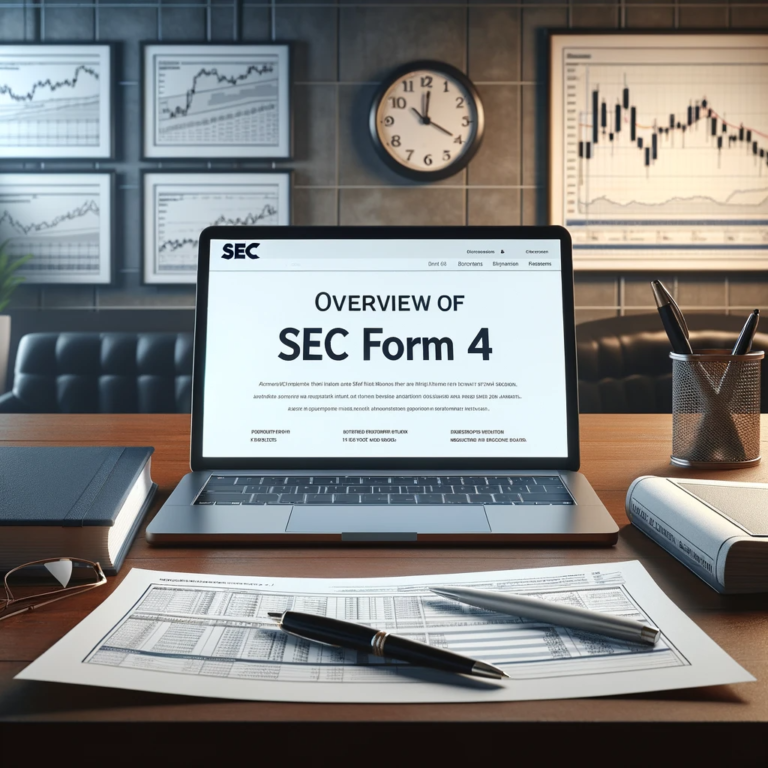Common SEC Form 4 Errors
Common SEC Form 4 Errors: When Tesla’s executives missed a filing deadline, they faced intense scrutiny and doubt from the market. You’re in the game of power, and you understand that overlooking the nuances of SEC Form 4 can sabotage your company’s credibility.
It’s not just about avoiding fines—it’s about maintaining the confidence of your investors and the authority of your brand. Whether it’s filing on time, detailing grant types accurately, or ensuring ownership details are spot-on, precision is non-negotiable.
You can’t afford slip-ups in reporting insider transactions. Embrace the sophistication of automated systems to prevent errors and streamline the process. This approach isn’t just about compliance—it’s about demonstrating your command over the finer points of corporate governance.
As you master SEC Form 4, you solidify your stronghold in the financial arena.
Key Takeaways
- Filing Deadline and Timeliness: Filing the Form 4 within two business days of the transaction is crucial, and proactive planning and automation can help ensure timely filing and reduce errors.
- Accurate Grant Reporting: Misreported grants should be promptly amended with a clarifying footnote, and accurate reporting of grant types and securities beneficially owned is essential for transparency and compliance.
- Grant Type Specification: Grant types should be accurately specified, and any incorrect listings should be promptly amended with a clarifying footnote. ISO/NQ splits should be reported together with precise share allocation.
- Ownership Details Accuracy: Accurate reporting of direct or indirect holdings is important to maintain authority and stakeholder trust. Discrepancies in ownership details can undermine compliance and investor confidence.
Understanding SEC Form 4

While you’re navigating the complexities of SEC filings, it’s essential to understand that Form 4 is a legally required document submitted by insiders to report changes in company stock ownership. This form serves as a critical tool for monitoring insider transactions, ensuring transparency, and maintaining market integrity. Each transaction must be disclosed with precision, adhering strictly to the terms and conditions set forth by the SEC.
Should discrepancies arise in your initial filing, an amendment to the form is often warranted. This amendment must concisely correct only the items in question, backed by a thorough explanation. In instances where an error is deemed immaterial, you have the discretion to address it in the next form, provided that the correction is made clear and adheres to the requirements for accurate disclosure.
It’s imperative to avoid a late filing; such an oversight suggests a lapse in governance and could invite scrutiny or fines. Rights reserved to the SEC to enforce penalties underscore the importance of timely and accurate submissions. In the event that a late filing is unavoidable, swift action to adjust the filing date is crucial to mitigate potential repercussions and reassert control over your compliance narrative.
Timeliness of Form 4 Filings

You must file your Form 4 within two business days following the transaction to comply with the SEC’s stringent deadlines. This tight window demands meticulous attention to detail and an unwavering commitment to process efficiency. Remember, the clock starts ticking the moment the transaction is executed, not when you start preparing the paperwork.
To avoid falling behind, consider these critical points:
- Proactive Planning: Arrange your administrative affairs so that necessary documents are prepared in anticipation of transactions.
- Automation Advantage: Leverage technology to streamline the filing process, minimizing the risk of human error and delays.
- Rigorous Review: Implement a systematic review protocol to catch and correct mistakes before submission.
These steps are non-negotiable for maintaining your company’s authoritative stance in the marketplace. Delays or inaccuracies in Form 4 filings can undermine stakeholder confidence and invite regulatory scrutiny, potentially culminating in severe penalties.
To seamlessly transition to the next critical compliance component, ensure your filings reflect not only timeliness but also rigorous attention to detail, especially when it comes to accurate grant reporting.
Accurate Grant Reporting

Accurate grant reporting on your Form 4 is essential to comply with SEC regulations and avoid hefty fines. You must meticulously record each grant, ensuring no duplications slip through. If you discover a misreported grant, you’re obligated to file an amended Form 4 promptly, complete with a clarifying footnote. This proactive correction demonstrates your commitment to transparency and regulatory adherence, crucial for maintaining investor confidence and corporate authority.
Your vigilance in listing the correct grant type is equally critical. Any discrepancy in this area requires immediate attention—a filed amendment and a clear, explanatory footnote are non-negotiable. Such precision in your disclosures fortifies your company’s reputation for reliability and control over compliance matters.
Moreover, the number of securities beneficially owned must be reported with unerring accuracy. Should errors occur, amend your Form 4 and elucidate the correction with a footnote. This attention to detail reflects your company’s dedication to factual integrity and its dominance in corporate governance.
Errors that could potentially mislead investors or impede the objectives of Section 16(a) carry significant weight. In such instances, seeking legal counsel isn’t merely advisable—it’s a strategic move to safeguard your power within the market.
Now, let’s delve into the intricacies of grant type specification, a pivotal aspect of your Form 4 reporting.
Grant Type Specification

It’s essential to specify the correct grant type on Form 4, as this reflects the nature and terms of the equity awarded to insiders. Overlooking this detail can misrepresent the transaction and have serious implications.
Here’s what you need to keep in mind:
- Amend Incorrectly Listed Grant Types: If you list an incorrect grant type in Column 1 of Table II, file an amended Form 4 promptly. This amendment must include the correct grant type and a footnote that clarifies the discrepancy.
- Address ISO/NQ Splits with Precision: For an incorrect ISO/NQ split, report both portions on the same line. Correct the share allocation meticulously to reflect the intended equity structure.
- Consult Legal Counsel for Material Mistakes: Evaluate the materiality of reporting errors with your legal counsel. They’ll guide you on whether a Form 4 amendment is warranted and ensure that your actions align with regulatory expectations.
You’re in a position of power, wielding influence over your company’s compliance and transparency. Avoid the pitfalls of inaccuracy; exactness in reporting isn’t just about avoiding sanctions—it’s about maintaining the integrity and trust that are the bedrock of your authority.
Ownership Details Accuracy

As an insider, ensuring the accuracy of ownership details in your SEC Form 4 filings is imperative to maintain regulatory compliance and investor confidence. It’s essential to meticulously report direct or indirect holdings to accurately reflect the number of shares in Table I or Table II. Any discrepancies can undermine your authority and the trust stakeholders place in your leadership.
When disclosing ownership, you must dissect each entry with a forensic level of precision. If inaccuracies surface, you’re required to swiftly file an amended Form 4. This signals to the market your commitment to transparency and rectitude. Remember, the gravity of material errors can’t be overstated; they possess the potential to mislead investors and skew compliance efforts regarding Section 16(a).
To wield power effectively, you must showcase responsibility. Timely correction of ownership details errors isn’t just a regulatory mandate; it’s a strategic move to preserve your reputation and the company’s standing. Your proactive approach in communicating any material errors to the market cements your status as a trustworthy and accountable leader. Always align your actions with the expectation of meticulous oversight that your position demands.
Addressing Minor Errors

How do you tackle those less significant slip-ups in your Form 4 filings without compromising compliance or investor trust? When dealing with minor errors, it’s essential to address them decisively and methodically. You want to ensure that any correction upholds the integrity of your disclosures and reflects a commitment to meticulous oversight.
Here’s what you need to focus on:
- Review and Document: Thoroughly review the nature of the error and document your findings. It’s critical to ascertain whether the mistake is indeed minor and doesn’t materially affect the overall accuracy of the filing.
- Internal Controls: Enhance your internal controls to prevent similar errors in the future. Implementing automated solutions like those from Supervizor can streamline this process and maintain rigorous compliance standards.
- Timely Correction: Correct the error in your next filing swiftly, ensuring that the correction is clear and unambiguous. Timely action demonstrates to investors and regulators that your company prioritizes accuracy and transparency.
Your approach to correcting these errors should be as analytical and precise as the data you aim to present. Maintain a robust system of checks and balances that reinforces investor confidence and complies with SEC regulations.
Leveraging Automation Benefits

Your company’s adoption of automated controls can significantly streamline the SEC Form 4 filing process, reducing the likelihood of errors and ensuring compliance. By leveraging cutting-edge technology from firms like Supervizor, you gain an analytical edge, transforming data into a pristine, error-free submission. The precision of automation meticulously scours through your financial disclosures, flagging discrepancies that demand attention. This high level of scrutiny is vital for maintaining the integrity of your filings.
The automation of controls isn’t merely a time-saver—it’s a strategic fortification against the risks of non-compliance. In your hands, automated tools become a powerful ally in the battle against fraudulent activities. They provide a robust framework for remote audits, permitting thorough reviews without the traditional constraints of location.
As a leader, you understand the imperative of compliance with anti-fraud regulations. Control automation arms you with the confidence to make informed decisions, backed by data that withstands rigorous examination. Embrace these technological advancements to solidify your company’s standing, safeguard your reputation, and enhance your command over the financial narratives that shape your enterprise’s future.
Common SEC Form 4 Errors FAQ’s
What Triggers a Form 4 Filing?
You’re prompted to file a Form 4 when there’s a change in stock benefits ownership by an insider, a move signaling control shifts that must be disclosed swiftly to maintain market integrity.
What Does Code F Mean on SEC Form 4?
You might think Code F on SEC Form 4 is just another box to check, but it’s key. It denotes a derivative security exercise, benefiting the company, and must be reported promptly. Handle it wisely.
Can You Amend a Form 4?
Yes, you can amend a Form 4. You’ll file only the corrected items and explain the changes in a footnote. It’s a power move ensuring accuracy and maintaining your company’s regulatory credibility.
Is Form 4 Good for Stocks?
Form 4 reveals insider stock trades, signaling confidence to you as an investor. Accurate filings can boost your stock’s value, while errors or delays might hint at deeper issues warranting your scrutiny.







